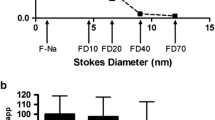Abstract
The pulmonary absorption kinetics of a single molecular weight distribution (MWD) of fluorophore-labeled poly-α,β-[N(2-hydroxyethyl)-DL-aspartamide] (F-PHEA), a hydrophilic and biocompatible synthetic polypeptide, were studied in the isolated, perfused rat lung (iprl) as functions of administered polymer concentration, dose, vehicle, and presence and absence of fluorophore. The MWD was characterized before and after absorption by measurement of weight- and number-averaged molecular weights (M wand M n, respectively) using high-performance gel-permeation chromatography. Values for M w and M n were 8.6 and 5.3 kD before, and 6.7 and 4.7 kD after, absorption into the perfusate; there was no significant metabolism and the MWD of the absorbed polymer was independent of both dose and sampling time over a 3-hr period. F-PHEA failed to show any evidence of aggregation in solution or changes in dose distribution within the airways as functions of increasing polymer concentration and dose. A concentration ranging study indicated the presence of a saturable, carrier-mediated transport process for F-PHEA with a maximum absorption rate, V max, of approximately 180 µg or 0.027 µmol/hr. Coadministration of fluorophore-free PHEA was capable of depressing the absorption of F-PHEA. The transport process for F-PHEA appeared to have a molecular weight limit of about 7 kD for this hydrophilic polymer.
Similar content being viewed by others
REFERENCES
R. W. Niven, F. Rypacek, and P. R. Byron. Solute absorption from the airways of the isolated rat lung III. Absorption of several peptidase-resistant synthetic polypeptides: Poly-2-(hydroxyethyl)-aspartamides. Pharm. Res. 7:990–994 (1990).
P. R. Byron, H. Katayama, Z. Sun, and F. Rypacek. Airway retention and pulmonary absorption of poly-α,β-[N-(2-hydroxyethyl)-D,L-aspartamide]. J. Biol. Comp. Pol. 6:25–35 (1991).
P. R. Byron, H. Katayama, Z. Sun, and F. Rypacek. Opportunities for protein delivery by aerosol. Pol Prep. 31:167–168 (1990).
P. R. Byron and R. W. Niven. A novel dosing method for drug administration to the airways of the isolated perfused rat lung. J. Pharm. Sci. 77:693–695 (1988).
P. R. Byron, H. Katayama, Z. Sun, and F. Rypacek. Opportunities for protein delivery by aerosol. Absorption and retention of several synthetic polypeptides in the lung. In R. L. Dunn and R. L. Ottenbrite (eds.), Polymeric Drugs and Drug Delivery Systems, ACS Symposium Series 469, American Chemical Society, Washington, DC, 1990, pp. 128–138.
P. R. Byron and M. J. Rathbone. Prediction of interfacial transfer kinetics. II. Solute ionization and aqueous phase ionic strength effects in two-phase transfer and rotating diffusion cells. Int. J. Pharm. 29:103–111 (1986).
P. R. Byron, N. S. R. Roberts, and A. R. Clark. An isolated, perfused rat lung preparation for the study of aerosolized drug deposition and absorption. J. Pharm. Sci. 75:168–171 (1986).
C. M. Metzler, G. L. Elfring, and A. J. McEwen. Package of computer programs for pharmacokinetic modeling. Biometrics 30:562–569 (1974).
P. R. Byron. Determinants of drug and polypeptide availability from aerosols delivered to the lung. Adv. Drug Deliv. Rev. 5:107–132 (1990).
T. H. Gardiner and L. S. Schanker. Absorption of disodium cromoglycate from the rat lung: Evidence of carrier transport. Xenobiotica 4:725–731 (1974).
S. J. Enna and L. S. Schanker. Phenol red absorption from the rat lung: Evidence of carrier transport. Life Sci. 12:231–239 (1973).
A. R. Clark and P. R. Byron. Drug absorption from inhalation aerosols administered by positive pressure ventilation. II. Effect of disodium fluorescein aerosol particle size on fluorescein absorption kinetics in the Beagle dog respiratory tract. J. Pharm. Sci. 74:939–942 (1985).
D. Wangensteen. Microstructural aspects of macromolecular transport across pulmonary epithelia. In R. N. Dalby and R. Evans (eds.), Proceedings of the Second Annual Respiratory Drug Delivery Symposium, University of Kentucky College of Pharmacy, Lexington, KY, 1991, pp. 117–140.
Author information
Authors and Affiliations
Rights and permissions
About this article
Cite this article
Byron, P.R., Sun, Z., Katayama, H. et al. Solute Absorption from the Airways of the Isolated Rat Lung. IV. Mechanisms of Absorption of Fluorophore-Labeled Poly-α,β-[N(2-Hydroxyethyl)-DL-Aspartamide]. Pharm Res 11, 221–225 (1994). https://doi.org/10.1023/A:1018947122613
Issue Date:
DOI: https://doi.org/10.1023/A:1018947122613




